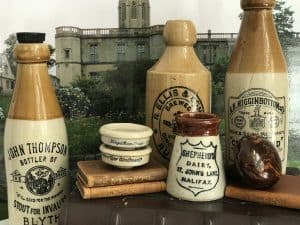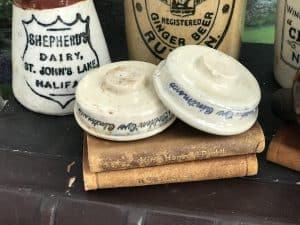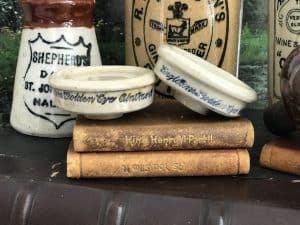 .
. .
.
Each lid differs slightly as each handmade – Measures Approximately 2.125″ diameter x .875″ tall
This is a listing for one (1) Singleton’s Golden Eye Ointment with blue transfer. Note, these are the earlier version that include the word “Golden” pre 1899. Great little addition to your Antique Advertising collection. Don’t miss out. These sell out quickly! I have two currently in stock.
Interesting history below captured from several websites including (ointment pots.com)
HISTORY:
The earlier Singleton’s pedestals carried the name Singleton’s Golden Eye Ointment, thereafter the word “Golden” was dropped, probably around 1899.
Pot shapes changed over the following years with the “foot” reducing in height size. All the pedestals carry lettering in blue print and vary in width and height sizes.
The ointment itself was placed on top of the pedestal and covered with a wax paper seal to preserve the ointment. These were distributed by the producers in a cardboard box.
The distinctive short rounded pot was the packaging for an ointment introduced in the 1700s. The ointment was made from a recipe dating from the late 1590s and passed down through the Singleton family by marriage.
(this info was taken from the Paul Barker’s ointment pot website on the internet and from the british museum.)
This pot was curated during my travels to England’s Antique Markets while visiting my daughter and her family in London.
The images attached are for the pot you will receive.
Most pots have some level of crazing , may have spots of discoloration, light hairline cracks and minor chips and fleabites that only add to its character and do not detract from its display value. These are expected due to age, use and let’s not forget they were often buried for decades before being dug up and rescued.
I offer substantial savings in shipping costs when multiple items are combined into one package. I work hard to find the most economical shipping options available by checking multiple discount carriers.
I will credit any overpayment of postage charged to you after finding the best shipping option. I check both ParcelMonkey.com and Shipgooder.com for the most economical delivery to save you shipping dollars. These companies negotiate better rates with USPS, Fed Ex and UPS than individuals can on their own.
| Weight | .5 lbs |
|---|---|
| Dimensions | 3 × 3 × 3 in |
Only logged in customers who have purchased this product may leave a review.

There are no reviews yet.